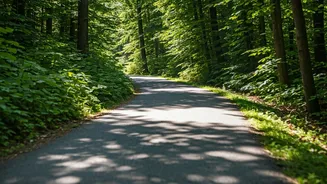Footwear: Crucial Choice
The cornerstone of a comfortable and effective walking routine lies in the choice of footwear. Doctors emphasize the importance of selecting shoes that
provide adequate support, cushioning, and fit. Look for shoes with good arch support to maintain proper foot alignment and reduce the risk of injuries. Consider the terrain you'll be walking on; for instance, trail shoes offer better traction and protection than street shoes. Ensure the shoes fit properly, leaving enough space in the toe box to prevent blisters and discomfort. It is also beneficial to replace shoes regularly, as the cushioning and support can deteriorate over time, affecting your gait and comfort. Remember that your feet carry you all day, so investing in the right shoes is an investment in your well-being.
Socks: Comfort is Key
Next to footwear, the right socks are vital for enhancing comfort during walks. Doctors recommend moisture-wicking socks made from materials like merino wool or synthetic blends. These socks help to keep your feet dry by drawing sweat away from the skin, preventing blisters and keeping your feet at a comfortable temperature. Avoid cotton socks, as they retain moisture, which can lead to chafing and blisters. Consider socks with extra cushioning in the heel and ball of the foot for added comfort and support. Choosing the right socks will significantly improve your overall walking experience, making each step more enjoyable and reducing the potential for discomfort or injury.
Hydration: Stay Refreshed
Maintaining proper hydration is critical for walkers, and doctors consistently emphasize the importance of drinking enough fluids. Carry a water bottle with you and sip water regularly throughout your walk, especially during warmer weather or longer outings. Dehydration can lead to fatigue, muscle cramps, and decreased performance. Aim to drink water before, during, and after your walk to stay hydrated. You might also consider electrolyte drinks for longer walks to replenish essential minerals lost through sweat. Always be mindful of your body's signals for thirst, and make a habit of drinking regularly to ensure you are adequately hydrated.
Sun Protection: Shield Yourself
Protecting yourself from the sun's harmful rays is crucial while walking outdoors. Doctors recommend applying sunscreen with a high SPF (Sun Protection Factor) to all exposed skin, even on cloudy days. Reapply sunscreen every two hours, or more often if you're sweating. Wear a hat to shade your face and neck, and consider sunglasses to protect your eyes from UV rays. Choosing clothing with UV protection is another effective way to shield yourself. The sun's exposure can lead to sunburn and increase the risk of skin cancer, so sun protection is an essential component of a safe and healthy walking routine, promoting long-term well-being.
Clothing: Dress Comfortably
Appropriate clothing choices are also important for a comfortable walk. Doctors advise wearing loose-fitting, breathable fabrics like moisture-wicking materials. This helps regulate your body temperature and keeps you comfortable regardless of the weather. In cooler weather, dress in layers to adjust to changing conditions easily. This allows you to remove or add layers as needed to maintain a comfortable temperature. Avoid heavy or restrictive clothing that might limit your movement and potentially cause overheating. Making the right choices about what to wear will help ensure that you can enjoy your walks no matter the season.
Safety: Be Visible
Enhancing your visibility is crucial, especially when walking near roads or in low-light conditions. Doctors advise wearing bright, reflective clothing. This helps drivers see you, increasing your safety. Consider using reflective accessories such as a vest, armbands, or shoe clips, especially if you walk in the early morning, evening, or at night. Avoid wearing dark clothing in these conditions. Walk facing traffic when possible if sidewalks aren't available. Being aware of your surroundings and taking steps to be visible are simple but highly effective ways to enhance your safety and enjoyment during walks.
First-Aid: Be Prepared
Preparing for potential emergencies is always advisable, so doctors recommend carrying a small first-aid kit. This should include essential items like bandages, antiseptic wipes, pain relievers, and any personal medications you might need. A blister treatment is also a great idea, along with tape. It is advisable to know basic first-aid techniques and familiarize yourself with how to handle minor injuries. If you're walking in remote areas or alone, consider carrying a charged mobile phone for emergencies. Being prepared for unexpected situations can help you handle them with confidence and reduce the impact of minor injuries.
Tracking: Monitor Progress
Finally, doctors often recommend tracking your walks to monitor your progress and stay motivated. There are many ways to do this, from using a simple pedometer to wearable fitness trackers or mobile apps. These tools can help you measure distance, time, pace, and calories burned. Monitoring your progress can provide valuable insights into your fitness levels and help you set and achieve your goals. Reviewing your data can also encourage you to make adjustments to your routine to optimize your results. Tracking not only helps you stay motivated but also ensures you're actively working towards achieving your goals.













